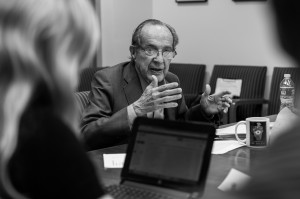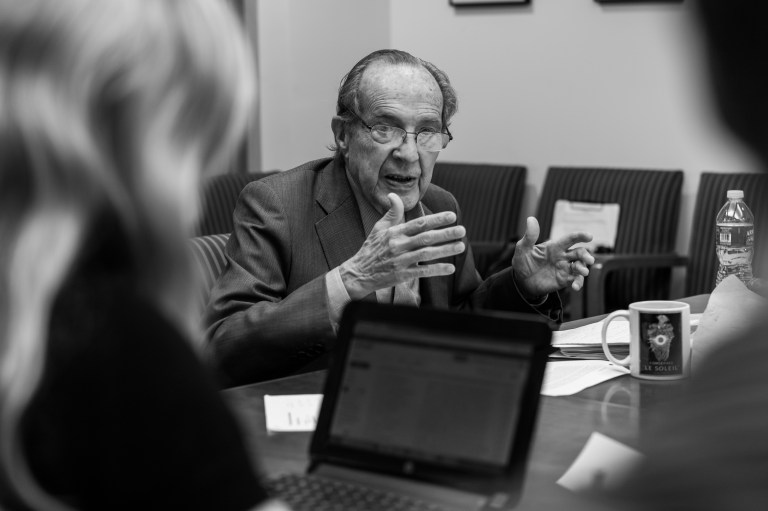One year after the atomic bomb was dropped on Hiroshima, Albert Einstein wrote: “The unleashed power of the atom has changed everything save our modes of thinking and we thus drift toward unparalleled catastrophe.”
Indeed, during the Cold War, we avoided an “unparalleled catastrophe” by the slimmest of margins. When the Cold War ended, we hoped that the danger of nuclear weapons ended with it. But that was not to be. The world today faces very different dangers than during the Cold War: a nuclear exchange between the US and Russia is, happily, only a remote possibility. But not at all remote is the possibility of a terror group detonating nuclear bombs in our cities. And a regional nuclear war — between India and Pakistan, or between Iran and Israel — is all too possible. Either could result in many millions of deaths, and would have huge and irreversible effects on our economy, our politics, our society, and all of civilization. Either of these events would be catastrophic beyond the imagination of most of us — a catastrophe that would fundamentally alter our way of life in profoundly negative ways.

In 1994, I became the Secretary of Defense and made it my top priority to do everything I could to reduce the danger of nuclear weapons. Using the newly passed legislation of the Nunn-Lugar program, I was able to facilitate the dismantlement of about 8,000 nuclear weapons, both in the US and in the former Soviet Union, and assist three nations — Ukraine, Kazakhstan, and Belarus — in removing all nuclear weapons from their lands. As a result of these actions, we are all safer. But many thousands of nuclear bombs still remain, far more than needed to assure deterrence; additionally, the nuclear powers continue to build nuclear weapons and new nations still strive to enter the nuclear club.
In 2007, believing we were drifting towards a nuclear catastrophe, I joined George Shultz, Sam Nunn and Henry Kissinger in the Nuclear Security Project, whose goal is to promote actions that reduce the number and the danger of nuclear weapons with the ultimate goal of eliminating them. Some important actions have been taken since then, notably New START, a treaty in which the US and Russia agreed to reductions in the number of deployed nuclear weapons, and two Nuclear Summits, which are designed to get better control of dangerous fissile material. But the actions taken have not been commensurate with the dangers we face. The basic reason for this lack of progress is that most Americans do not understand the nuclear dangers we face today — they believe that the ending of the Cold War brought about the ending of nuclear dangers. In truth, nuclear dangers today are all too real — and they are grave.
In response to the growing threat, I have embarked on a new initiative to raise the awareness of our citizens about the nuclear dangers they face and what actions they can take to lower those dangers. Under the sponsorship of the Nuclear Threat Initiative (a nonprofit organization in Washington, DC co-chaired by Sam Nunn), the William J. Perry Project includes a memoir, tentatively titled “A Journey at the Nuclear Brink,” and the creation of education programs specifically directed at younger generations, who have not personally experienced the nuclear crises of the Cold War generation.
To launch the education program, the Perry Project invited 10 undergraduates from three universities to study messaging about nuclear dangers and make recommendations on how best to increase understanding and engage their generation in these issues. The Summer Study Group, which includes students from Stanford, UCLA, and George Washington University, launched their work at a kickoff meeting June 20-21 at Stanford, where they met with national security leaders and nuclear experts including George Shultz, David Holloway, Ward Wilson, the Reverend Tyler Wigg-Stevenson, Jim Baird and myself. The sessions ranged from an open conversation with former Secretary of State George Shultz to presentations on a world without nuclear weapons, the role of faith-based communities in addressing nuclear dangers, myths about nuclear weapons and public attitudes towards nuclear weapons. Students engaged in Q&A sessions with the speakers and also participated in team-building exercises designed to help them work effectively together over the summer when they will be working from different locations.
The energy and enthusiasm throughout the two-day meeting was palpable and I am encouraged by their passion and commitment to making a difference on nuclear danger. I came away believing that new ways of communicating these dangers will be key to engaging their generation in this important work — and I believe that these students in particular are ready to roll up their sleeves and help us figure out how to carry the cause forward. They will convene again at Stanford in September to present their findings and we — along with many of my nuclear security colleagues from all over — will be listening intently to what they tell us.
William J. Perry ’49 M.S. ’50 served as Secretary of Defense from 1994 to 1997 and is currently a senior fellow at the Freeman Spogli Institute for International Studies.
